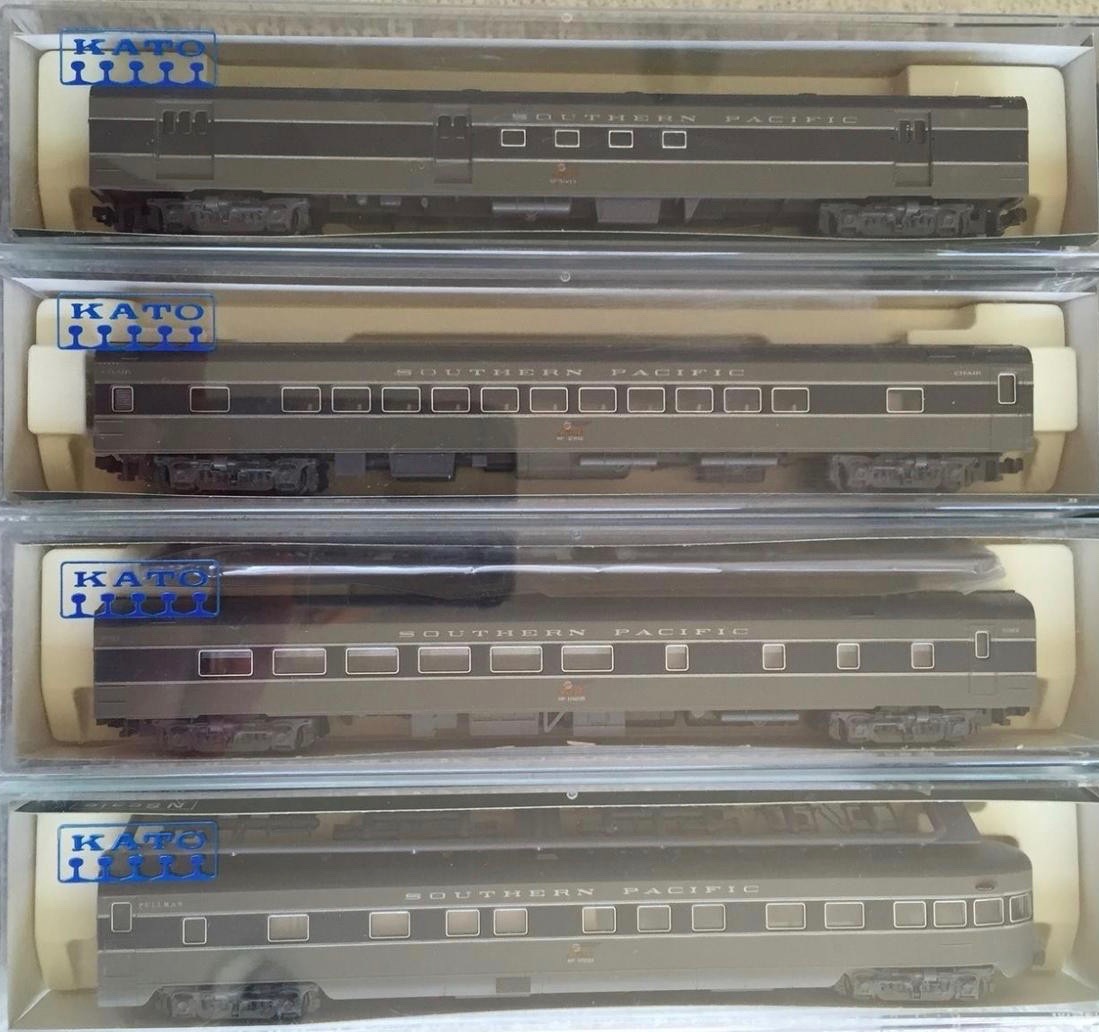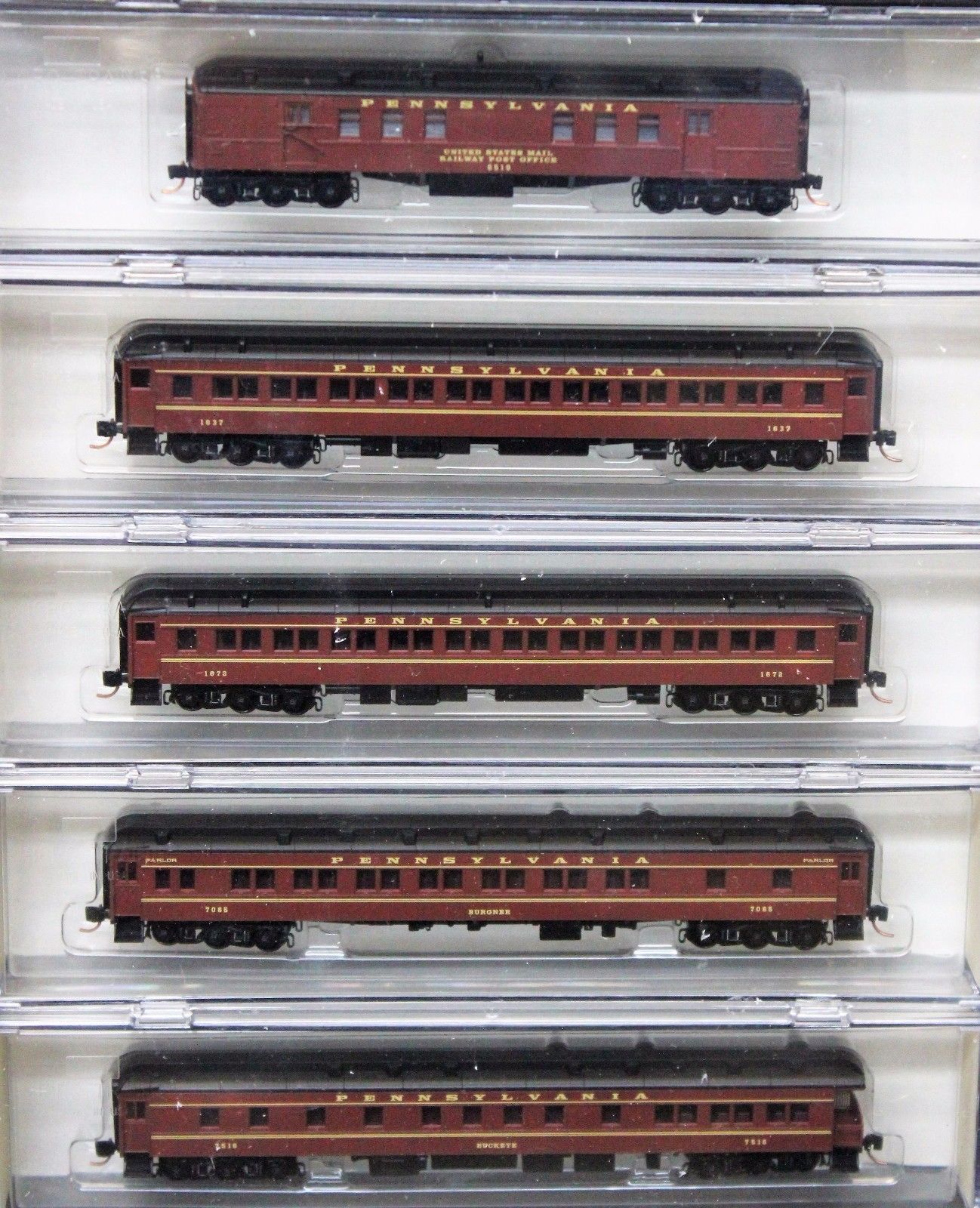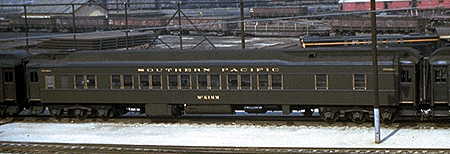Specific Item Information: This 12-1 heavyweight sleeper car is Pullman green with gold lettering and runs on 6-wheel passenger car trucks. This car was used on trains on the Union Pacific Railroad system in the 1940s-1950s. Union Pacific is now exclusively a freight railroad with over 32,000 miles of track, but prior to 1971, UP also operated numerous passenger trains and services.
Prototype History: Pullman was the leading producer of heavyweight coaches during the 1st half of the twentieth century. They were known for the quality and luxury of the passenger cars. The observation car was a common sight on heavyweight consists during 1920s and 1930s.
Sleeping, parlor and lounge cars of riveted carbon steel body-frame construction were built, owned and operated by the Pullman Company. These cars were better known by the name "Heavyweight Cars." Between March 1907 and February 1931 there were 8011 cars built.
The first steel passenger cars were 12-1 sleepers, such as this Plan 2410, which are simply a steel adaptation of the "Varnish" Plan 1963 car - "gothic" arched windows and all. 12-1s of the Plan 2410 and 3410 are one of the relatively few steel designs in true mass production: being churned out in 100+ lots for a total over 4000 units: 40% of the entire Pullman steel fleet.
The spread of accommodations is interesting: the lowest level of Pullman space - the open section - together with the best - a drawingroom. Sleeper cars have a relatively low occupancy capacity, and Pullman has long held to the open sections for maximum payload. The drawingroom on 12-1s is actually intended for families: the High And Mighty prefer all-room cars.
Some typical features of these cars are the two large restrooms (the mens room - at left - is also the smoking lounge while the ladies have a vanity table in their restroom). The drawingroom has an arrangement similar to the sections, plus a sofa which makes up into a third berth. The drawingroom, of course, has its own facility. Externally we see that the traditional clerestory vents have been replaced with the new sheet metal ventilators. These use the forward motion of the car to create a draft through the fore-and-aft openings which, in turn, causes a venturi effect drawing fresh air into the car through the center openings.
Sleeping, parlor and lounge cars of riveted carbon steel body-frame construction were built, owned and operated by the Pullman Company. These cars were better known by the name "Heavyweight Cars." Between March 1907 and February 1931 there were 8011 cars built.
The first steel passenger cars were 12-1 sleepers, such as this Plan 2410, which are simply a steel adaptation of the "Varnish" Plan 1963 car - "gothic" arched windows and all. 12-1s of the Plan 2410 and 3410 are one of the relatively few steel designs in true mass production: being churned out in 100+ lots for a total over 4000 units: 40% of the entire Pullman steel fleet.
The spread of accommodations is interesting: the lowest level of Pullman space - the open section - together with the best - a drawingroom. Sleeper cars have a relatively low occupancy capacity, and Pullman has long held to the open sections for maximum payload. The drawingroom on 12-1s is actually intended for families: the High And Mighty prefer all-room cars.
Some typical features of these cars are the two large restrooms (the mens room - at left - is also the smoking lounge while the ladies have a vanity table in their restroom). The drawingroom has an arrangement similar to the sections, plus a sofa which makes up into a third berth. The drawingroom, of course, has its own facility. Externally we see that the traditional clerestory vents have been replaced with the new sheet metal ventilators. These use the forward motion of the car to create a draft through the fore-and-aft openings which, in turn, causes a venturi effect drawing fresh air into the car through the center openings.
Road Name History: The Union Pacific Railroad (reporting mark UP) is a freight hauling railroad that operates 8,500 locomotives over 32,100 route-miles in 23 states west of Chicago, Illinois and New Orleans, Louisiana. The Union Pacific Railroad network is the largest in the United States and employs 42,600 people. It is also one of the world's largest transportation companies.
Union Pacific Railroad is the principal operating company of Union Pacific Corporation (NYSE: UNP); both are headquartered in Omaha, Nebraska. Over the years Union Pacific Corporation has grown by acquiring other railroads, notably the Missouri Pacific, Chicago & North Western, Western Pacific, Missouri-Kansas-Texas, and the Southern Pacific (including the Denver & Rio Grande Western).
Union Pacific Corporation's main competitor is the BNSF Railway, the nation's second largest freight railroad, which also primarily services the Continental U.S. west of the Mississippi River. Together, the two railroads have a duopoly on all transcontinental freight rail lines in the U.S.
Read more on Wikipedia and on Union Pacific official website.
Union Pacific Railroad is the principal operating company of Union Pacific Corporation (NYSE: UNP); both are headquartered in Omaha, Nebraska. Over the years Union Pacific Corporation has grown by acquiring other railroads, notably the Missouri Pacific, Chicago & North Western, Western Pacific, Missouri-Kansas-Texas, and the Southern Pacific (including the Denver & Rio Grande Western).
Union Pacific Corporation's main competitor is the BNSF Railway, the nation's second largest freight railroad, which also primarily services the Continental U.S. west of the Mississippi River. Together, the two railroads have a duopoly on all transcontinental freight rail lines in the U.S.
Read more on Wikipedia and on Union Pacific official website.
Brand/Importer Information: Micro-Trains is the brand name used by both Kadee Quality Products and Micro-Trains Line. For a history of the relationship between the brand and the two companies, please consult our Micro-Trains Collector's Guide.
Manufacturer Information:  Micro-Trains Line split off from Kadee Quality Products in 1990. Kadee Quality Products originally got involved in N-Scale by producing a scaled-down version of their successful HO Magne-Matic knuckle coupler system. This coupler was superior to the ubiquitous 'Rapido' style coupler due to two primary factors: superior realistic appearance and the ability to automatically uncouple when stopped over a magnet embedded in a section of track. The success of these couplers in N-Scale quickly translated to the production of trucks, wheels and in 1972 a release of ready-to-run box cars.
Micro-Trains Line split off from Kadee Quality Products in 1990. Kadee Quality Products originally got involved in N-Scale by producing a scaled-down version of their successful HO Magne-Matic knuckle coupler system. This coupler was superior to the ubiquitous 'Rapido' style coupler due to two primary factors: superior realistic appearance and the ability to automatically uncouple when stopped over a magnet embedded in a section of track. The success of these couplers in N-Scale quickly translated to the production of trucks, wheels and in 1972 a release of ready-to-run box cars.
Micro-Trains Line Co. split off from Kadee in 1990 to form a completely independent company. For this reason, products from this company can appear with labels from both enterprises. Due to the nature of production idiosyncrasies and various random factors, the rolling stock from Micro-Trains can have all sorts of interesting variations in both their packaging as well as the products themselves. When acquiring an MTL product it is very important to understand these important production variations that can greatly enhance (or decrease) the value of your purchase.
Please consult our Micro-Trains Collector's Guide

Micro-Trains Line Co. split off from Kadee in 1990 to form a completely independent company. For this reason, products from this company can appear with labels from both enterprises. Due to the nature of production idiosyncrasies and various random factors, the rolling stock from Micro-Trains can have all sorts of interesting variations in both their packaging as well as the products themselves. When acquiring an MTL product it is very important to understand these important production variations that can greatly enhance (or decrease) the value of your purchase.
Please consult our Micro-Trains Collector's Guide
Item created by: CMK on 2021-08-03 04:57:33. Last edited by CMK on 2021-08-03 05:06:08
If you see errors or missing data in this entry, please feel free to log in and edit it. Anyone with a Gmail account can log in instantly.
If you see errors or missing data in this entry, please feel free to log in and edit it. Anyone with a Gmail account can log in instantly.










